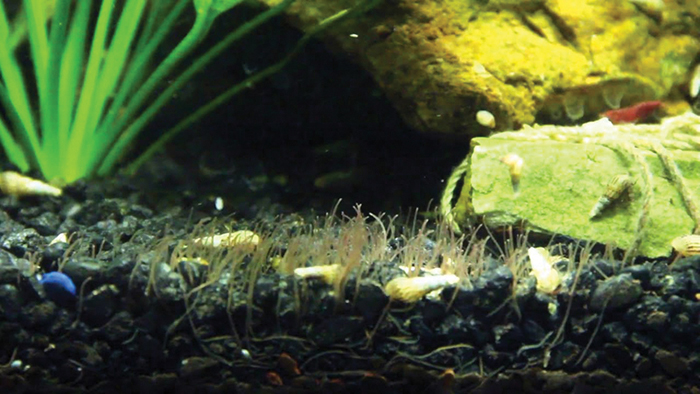
There are bugs — and then there are bugs when it comes to our koi. In this article, we are going to forget about the familiar Ich that every hobbyist thinks of first when their fish start flashing. We can also forget about the internal cestodes, like internal flukes and tapeworms — the ones that require Praziquantel to treat.
Today we will focus on the external, visible-to-the-naked-eye, crustacean type of bug and a few others that are often overlooked. We will look at two crustaceans that are both capable of killing fish right under our noses — the Argulus (fish lice) and the Lernea (anchor worm).
I had never experienced Argulus or Lernea in a goldfish bowl as a child, nor did I see these crustaceans in my aquarium when I was a teenager. To me, crustaceans are ocean crabs, lobsters, crayfish, krill and so on. It wasn’t until I started keeping koi in the early 1990s that a whole new world of surprises opened up. I learned how to use a microscope and do intraperitoneal injections without hitting any vital organs on my fish. A whole new world of knowledge was opening before me — veterinary care of my own fish.
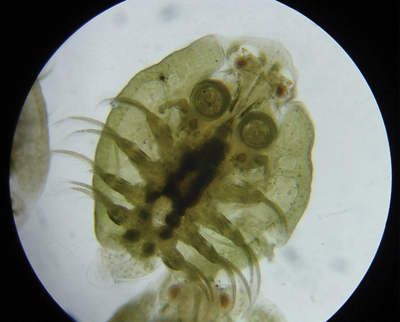
One day I was taking a close look at my pond and found a few leeches. I didn’t think leeches were a good thing, so I went to Pondinformer.com. “Plant leeches and predatory leeches are not harmful to pond fish, and not all blood-sucking species are actually capable of using fish as their hosts.”
Good news! But I kept reading. “There is one species of leech to watch out for if you have goldfish and koi, and that is the fish leech (piscicola geometra). These long, worm-like leeches are capable of attaching themselves to fish and sucking blood from their host, which can lead to dangerous infections and stress. The adult leeches are around 2.5 centimeters long and often arrive to the pond attached to fish or inside pond plants. They’re difficult to catch, as they can attach themselves to any part of the fish to feed and often like to hide away within the gills and under the fins.

“The leeches, although unpleasant for the fish, are not deadly by themselves. The problem is the open wounds they leave, which can lead to nasty infections, both viral and bacterial. In terms of a leech’s life cycle, this varies depending on the species, but the most common fish leech, piscicola geometra, has a 30-day life cycle. This relatively short cycle can be used to our advantage to help starve the leech and prevent the eggs from hatching and finding a meal — hence why a quarantine period is very effective.”
So, there are leech traps, chemical agents to clean the pond and, perhaps, better filtration. But the key to no leeches is always prevention.
In fact, it turns out these pests were there because of detritus buildup. It was time to clean the pond. Even Pondinformer.com’s No. 1 recommendation is “Clean up the sludge/muck in the bottom!”
What? The Muck?
But there’s even more! I found small red worms in the filter. There were lots and lots of these. My stomach did flips until I these I learned they were nothing but Aquatic Midge larvae and the same type of bloodworm I used to feed my tropical fish (Tubifex). A new filter pad would also help, and using Bacillus thuringiensis israelensis (Bti) bacteria in the pond would get rid of the Aquatic Midge, mosquito and black fly larvae. At four or five years into the hobby, I had thought I was a conditioned hobbyist.
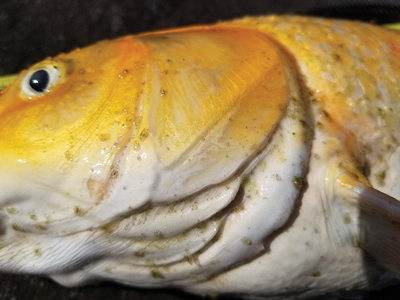
When the company I had joined started manufacturing a lice and anchor worm treatment, I started researching these parasites. There are some notable differences between anchor worms and fish lice, although both are lethal to the pond fish. I dug into their life cycles, effects of temperature on each and how eggs remain at the bottom over the winter months. I needed to know everything about them. I learned that anchor worms look like small pieces of white threads hanging from the fish, with their heads firmly embedded into the skin beneath the scales. That should be easy enough to see when purchasing a new fish.
I also learned that fish lice are nearly translucent, but if you look carefully, they are quite visible — greenish or grayish, depending upon the color of fish, and disc shaped with two “eyes” on them. They tend to mass together in one or more areas on the fish, like the tail, gill area or dorsal. Where they bite into the fish, they leave an opportunity for Aeromonas or fungal infection to enter. Actually, both lice and anchor worm open the fish to infection, and both are capable of killing the fish. However, I had not seen or experienced either of them personally yet.
Anchor Worm Spread
From the Tropical Aquaculture Laboratory, I learned that different life stages of Lernea live on and off the fish. After anchor worms finish mating, the male dies, and the female bores into the male’s tissue, using a large anchor on her anterior “head” end to permanently secure itself into the skin and muscle of the fish. The female matures into an adult, and within 24 hours, she may begin to release eggs. Each egg hatches within 24 to 36 hours, and females are very prolific. They can produce batches of up to 250 juveniles every two weeks for up to 16 weeks at water temperatures warmer than 77°F.
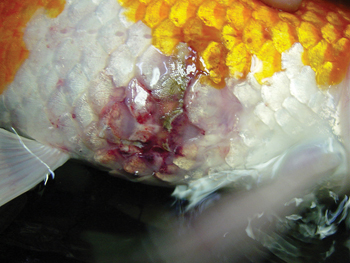
Anchor worm contamination in a pond can be caused by birds eating infected fish and then infecting another pond with its feces, thus causing the cycle to begin again. It can also be introduced by an infected fish, so it is important to carefully examine any new fish before they are released into the pond. An anchor worm infection can spiral out of control in a pond at an alarming rate. If left unchecked, the worm itself can cause major damage to the fish and potentially spawn major infections.
While Lernea is extremely damaging if not caught in time, the parasite can be removed through the use of potassium permanganate. When used as a dip, anchor worms will release their hold from the side or back of the fish and can be gently swept away.
Fish Lice Outbreaks
The Argulus life cycle averages 30 to 60 days, depending on the species (yes, there are more than one) and water temperature. All life stages of both sexes are parasitic. Argulus japonicus eggs hatch in 10 days at 95°F but require 61 days at 59°F. Argulus foliaceus hatches in 17 days at 73°F, but at 68°F, they hatch in 30 days. If laid in the fall, the eggs will survive over the winter until the following spring. In many species, the larvae must find a host within 2 to 3 days of hatching, or they will die.
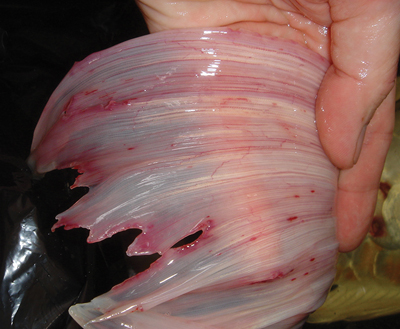
Therefore, a crowded pond is a giveaway for the hatchlings. Once attached to the fish host, juveniles undergo a series of molts (11 molts, or 12 “stages” in Argulus foliaceus) until they reach sexual maturity approximately 30 to 40 days after hatching.
Fish without visible lice may show non-specific signs of infestation. These symptoms include spot or pinpoint hemorrhages, anemia, fin and scale loss, increased mucus production, lethargy, erratic swimming, reduced feeding, hanging at the surface (avoiding swimming into the water column) and poor body condition. Fish may flash, or rub against surfaces, in an attempt to relieve irritation or remove the parasites. In some cases, there may be no obvious drug choice, and the length of treatment for fish lice infections should take into consideration the life cycle of the parasite, which varies from 30 to 60 days, depending on temperature and species.
Koi fish lice is a crustacean, or “branchiurian” parasite most commonly found in koi ponds, but it is occasionally found in an aquarium. In an aquarium, the eggs are found in tubular structures on the glass and ornaments. In a pond, they are nearly impossible to find.
Dead Fish Tell the Tale
Treatment must target all life stages, including eggs, juveniles and adults, both on the fish and in the environment. Adult parasites can be manually removed from the affected fish, but this is impractical in many situations. It’s also an incomplete solution, because eggs, unattached juveniles and adults will still be present in the environment.
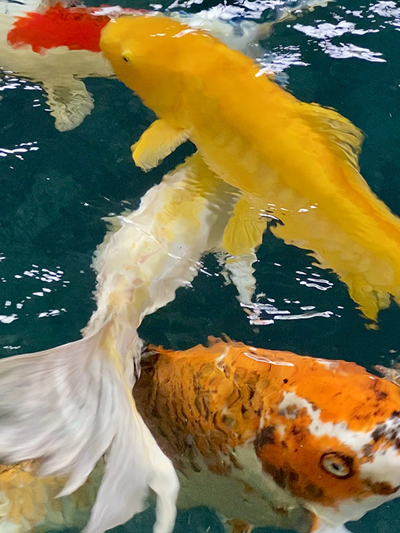
My actual introduction to fish lice came when a customer called for help. His fish were dying. After asking questions and ruling out the most likely causes of fish deaths in a mature pond, I learned that he had added several new fish about a year before. He did not quarantine them, as many hobbyists choose to do, due to space restrictions.
Naturally, he saved the dead fish to show me. I told him, “Dead fish tell no tales.” But, in this case, it told the whole story. He insisted on sending me the photos of his dead fish, as he could see nothing wrong with them. Reluctantly, I viewed the pictures.
In the first picture, I noticed nothing. But the second picture was a close-up, and it was a remarkable shot of what had happened to his fish. On one hand, I could understand how an uneducated eye did not recognize the problem. And yet, to me, it seemed so obvious. I could almost feel the pain and suffering the poor fish had undergone.
He had to treat his pond with Cyromazine, an insect growth regulator also used by veterinarians for fleas and ticks, which has proven quite successful in preventing the completion of molt, which these parasites have to go through continually throughout their life cycle. He also manually removed the adults from his fish for a better outcome.
This is an important lesson for pond builders and their customers when fish begin to die. Sometimes, we don’t need a microscope to help them find the problem.


